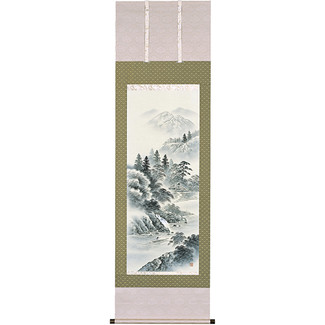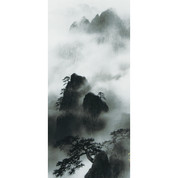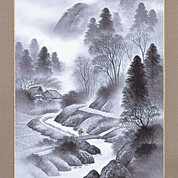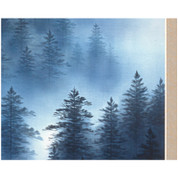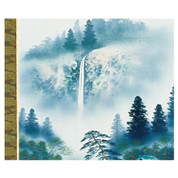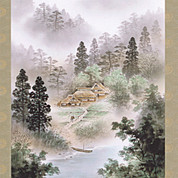- Home
- BY PRICE
- Standard Grade
- Landscape (G) - with Paulownia Wood Box
- Home
- TEAWARE
- KAKEJIKU JAPANESE SCROLL
- Landscape (G) - with Paulownia Wood Box
Kakejiku
Hanging Scroll
Landscape (G) - with Paulownia Wood Box
- PRICE:
- $453.00
- SKU:
- F9-9O3I-Y3T7
- Availability:
- We will ship within 3-5 days after receiving cleared payment.
- Shipping:
- Calculated at checkout
| Shipping: | Standard Int'l Shipping(2-7 days) Item location: Chuo-ku, Tokyo, Japan |
|---|---|
| Delivery: |
Seller ships within 3-5 days after receiving cleared payment. |
| Payments: |

|
| Returns: | Please refer the return policy in detail. |
Product Description
** This item is made hand so it may have a little difference in color and drape. It may take time (a few weeks) from your order to shipping. Your understanding is greatly appreciated.**
PLEASE NOTE:
- This is a brand new arts and crafts item that was carefully created by a traditional Japanese artist. (100% made and crafted in Japan)
- This is not an antique product.
- It is not a one of a kind only production.
- It may take time (a few weeks) from your order to shipping. Your understanding is greatly appreciated.
- As this product is made individually by hand, design, size, color or design may be slightly different from the sample picture. We hope you enjoyed the uniqueness of this product.
Kakejiku (Japanese Hanging Scroll)
In Japan, Kakejiku has been used for special occasions and for cherishing the changing of seasons. Kakejiku plays an important role of welcoming guests as well as delivering a new season's arrival or decollating a day-to-day life style.
Kakejiku adds beautiful colors to any rooms, stores, business and events and is considered something that brings a great atmosphere.
Kakejiku's History
Kakejiku arrived Japan from China during Asuka Period (from 592 to 710 A.D.) as a tool to "Spread the Buddhism". Around that time period, Kakejiku had a Buddha picture, and was commonly used for worship by hanging up on a wall. It did not have a connotation of decollation as it is commonly used now.
When the Tea Ceremony gained popularity among Samurai during Azuchi-Momoyama Period (from 1,573 to 1,603), and with the influence of Sen No Rikyu (he is the creator of tea ceremony and considered one of the best masters), hanging up Kakejiku in the alcove of the tea ceremony room became an important custom. It delivered the sense of the change of seasons, notifying different time (morning, dawn or night) accordingly while welcoming guests.
During Edo Period (from 1,603 to 1,867), Kakejiku was widely spread amongst the regular People Class. There were not so many wars during that period, what we call the "Tranquility" era that flourished arts and cultures. Prior to the Edo Period, only certain authorities could afford to have an alcove in their houses, however, with the spread of the alcove, the People Class house opened up the door to owning Kakejiku.
Since then, alcove and Kakejiku have been considered one of the "must-haves" for Japanese culture and houses. These days, Kakejiku is considered "Art" or "Interior Decollation" from collectors around the world.
How to unpack and hang Kakejiku properly
Please watch the video together with reading the following instructions.
[How to unpack and hang Kakejiku]
- 1. Unroll the string and unwrap the paper. Hold the tassels to the opposite sides first so they hang straight down.
- 2. Unroll Kakejiku for about 60 cm, just enough to be able to place the hock bar. Place a hanging bar around the hanging string.
- 3. Place the string on the picture frame hardware on the wall and release the bar. Using both hands, unroll Kakejiku completely.
- 4. Walk 3 to 5 feet away from Kakejiku, and make sure it is straight.
*Place Fuchin (a weight to put on the tip of Kakejiku) if necessary.
[How to roll Kakejiku]
Reverse the how to hang steps. First take Kakejiku off from the wall using the bar.
When storing, make sure to hold the tassels horizontally.
Place the paper for the top part of Kakejiku.
- 1. Roll Kakejiku softly by holding the tip. Make sure not to roll too tight as it may result in creating curls and wrinkles.
- 2. After rolling Kakejiku up, place the string in the center of Kakejiku and wrap three times.
- 3. Hold down the string that is hanging. Place it under the cord and pull upwards.
- 4. Place the pulled string under the cord to tighten it. Do not tighten by making a knot as it will affect the surface area of Kakejiku.
- 5. Store in a box.
*If your Kakejiku comes in a box of paulownia wood, you will find a compartment inside. Place Kakejiku in the larger compartment of the box, and make sure the top of Kakejiku is facing up in the smaller compartment.
[How to take care of your Kakejiku]
= Store in a box =
We highly recommend storing your Kakejiku in a paulownia wood box, which is an excellent dehumidifier and moth protector.
Most of our Kakejiku are stored in paulownia boxes. *The box material varies by product. If you are using a paper box, please consider purchasing a paulownia wood box to protect your Kakejiku.
= How to take care of Kakejiku =
1. Please air out Kakejiku at least once a year. *For sun drying and airing.
2. Do not let Kakejiku hang off the wall for a long period of time. At least once every two to three months, alternate with your other Kakejiku.
3. Make sure to select a sunny day when changing Kakejiku.
*If you store Kakejiku for a long period of time, stain, moth or other bug related issue may occur from the humidity.
More details about Kakejiku art theme
Landscape
Generally speaking, landscape is large scenery of nature that includes deep mountains, flowing rivers, trees and rocks. It is not a simple landscape painting as you would imagine. Along with the teachings of Taoism and Zen, every single landscape you find in Kakejiku has its own unique expressive meaning. Including a peaceful mind far away from the worlds restraints.
Tucked away in the valley is a utopia of artists. Persons appearing there are the inspirations and admirations of writers and artists, as they are the symbol of freedom, not bound to anything. Landscape paintings are made from the supermundane spirit of the artist. They will give you the feeling of being in a peaceful world.
PRODUCT INFO
Country: Japan
Grade:Economy
Artist (Craftsman):RINGAI UEDA
Size:W54.5 * H190 cm (W21.46 * H74.8 inc)
Weight: about 465 g/16.4 oz
Material: Paper
Fuchin (a weight to put on the tip of Kakejiku):Wood
Box:
-PaulowniaWood
- Comes with a note of authenticity
- Box Weight: about 685 g/24.16 oz

